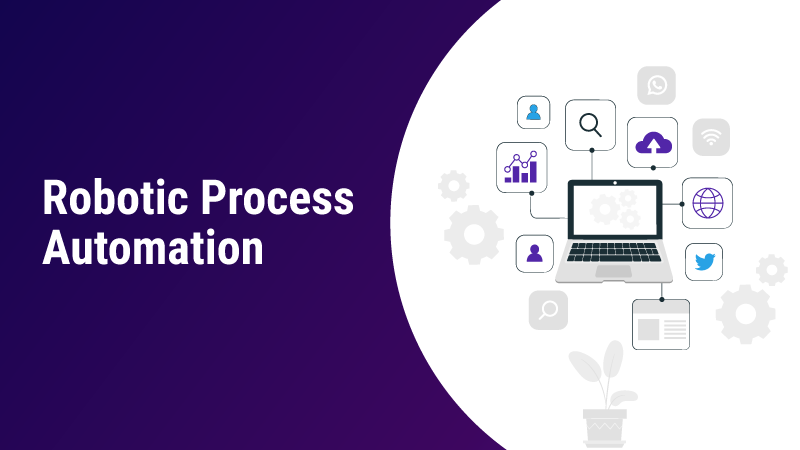Use Cases of RPA in the Insurance Industry

Robotic Process Automation (RPA) is compatible with many insurance processes, especially those that require a physical or manual workforce, like handling applications, registration and processing of claims, and data entry. The insurers are able to take advantage of the constant accuracy of an RPA software bot that performs tasks tirelessly and flawlessly at the required level at a small cost.
Implementing Robotic Process Automation in the insurance sector significantly sets the industry to become more customer-centric and efficient as a whole. There are many insurance companies that have sophisticated systems globally, various languages, regulations – rules, a complete necessity for data security, precision, risk elimination, and efficacy in processing. Hence, RPA bots can focus on certain activities that can essentially change the working of the industry.
Use Cases of RPA in insurance
The ability of RPA to unify back-office environments with front-end technologies in order to automate end-to-end lifecycle processes is what makes the technology a perfect fit for the insurance sector. Let us discuss the major areas in the insurance sector where we can implement RPA:
Claim registration and processing
Companies are required to collect a lot of information from multiple sources, which create comprehensive data, for the claim processing. Existing claim systems are not functional or flexible enough and have exceeded their practical limits, resulting in immoderate manual processing. This in turn reduces efficiency and flexibility, hence the service gets delayed and adversely affects customer satisfaction. Robotic Process Automation in the insurance industry unifies various information regarding claim processing from different sources. It enables automating various processes including data extraction, difficult error tracking, claims confirmation, and unification of claim-relevant data sources; as a result, the process speeds up and forms a better customer experience.
Underwriting
Underwriting needs assessing clients’ risks and exposures and it usually takes more than 2-3 weeks to entangle, analyze and determine the risks involved before coming to a conclusion. Robotic process automation facilitates the automation of a process that involves data gathering from multiple external and internal sites, hence minimizing the time for consumed underwriting. RPA also helps to provide necessary information to various fields in internal systems and to prepare a report or create suggestions while evaluating run losses, therefore automating the underlying process of product underwriting and pricing.
Regulatory compliance
The insurance industry adheres to strict regulations in archiving works and generating audit trails. In order to assist the companies to enhance the regulatory process, automation is significant as it eliminates the need to deploy employees to carry out operations to manually impose regulatory compliance. Verifying the details of existing customers, creating regulatory reports, and sending account closure processing notices are just a few of the situations that get automated with RPA implementation.
Integration with legacy applications
To handle business processes smoothly, insurance companies are highly dependent on legacy applications. As Enterprise Resource Planning (ERPs) or Business Process Management (BPM) needs incorporation with legacy applications, implementing them can be really challenging. The fact that RPA can adapt to the current workflow of insurance companies means that it can adapt to any type of system available for well-structured RPA implementation.
Process and business analytics
A bundle of functional and paper-based processes in insurance companies makes it intricate to monitor and measure performance or find out improvised areas. It is easy to monitor the performance of software bots with the help of automation. Since the audit trial given by RPA also assists regulatory compliance, it supports process improvement as well. Thus, improving claims and response to customer service.
How to implement RPA in Insurance?
Execution of Robotic Process Automation technology in the insurance sector can be complex and the impact is multifaceted. Therefore, it needs a well-organized plan and knowledge about the impact on multiple departments in a company. Below given are a few steps required to implement RPA successfully.
Find the right process
It is very important to perform a top-down analysis of end-to-end processes to find out the most appropriate opportunities for RPA. At this stage queries regarding the methods (whether it has to be standardized or redesigned) need to be addressed before automation.
Define vision and strategy
Set up a perfect strategy or route map for measuring RPA deployment. The main checkpoints for defining a strategy include three steps:
- Explaining the flow of the process in steps and stages.
- Deciding powerful processes or tools that facilitate dynamic delivery.
- Creating the plan for automation by plotting each stage of the process.
Set up governance and authority
Making sure that an automation program is run by a C-suite member helps greatly in securing timely checkpoints. Moreover, to keep the business as usual (BAU), coordination must be there between the IT and the operations department.
Foresee talent impact
The influence of automation on traditional roles and the assurance of shareholder purchases is inevitable and can never be transferred. A well-organized approach is crucial in enabling the most appropriate way to involve the employees and it is essential to build a promising environment among workers, as an organization.
Wrap Up
When it comes to the insurance industry, insurers keep facing challenges because of the rapid development of customer demand and high competition. As the insurance industry became increasingly backed by the efficacy of back-office processes, insurers began to adopt Robotic Process Automation to automate rule-based activities, transactions, and routines, in order to rebuild the capability and capital for more intricate and strategic tasks.
Apart from the ease of using RPA bots, it can also assist insurers to attain higher profits, better compliance, long-term growth in the company, and best customer service while reducing costs and eliminating drop out of customers. Considering the advantages and scalability offered by RPA technology, it is hoped that the insurance sector will increase the implementation of RPA to a higher rate. Robotic process automation is used to promote long-term success prospects and product markets.
Get Started with our RPA ServicesRead more about RPA
Blogs by Category
AppForms Artificial Intelligence Blockchain Call Centers Chatbots Cloud Computing Data Management Design Digital Marketing Digital Transformation Enterprise Applications FinTech Insights LowCode Development Microsoft Mobile Apps News Office 365 Robotic Process Automation Security SharePoint Software Development Web ApplicationWhat is Robotic Process Automation? RPA Explained

2024-05-23 16:56:57